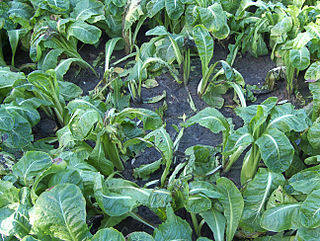Pseudomonas avellanae is a Gram-negative plant pathogenic bacterium. It is the causal agent of bacterial canker of hazelnut. Based on 16S rRNA analysis, P. avellanae has been placed in the P. syringae group. This species was once included as a pathovar of Pseudomonas syringae, but following DNA-DNA hybridization, it was instated as a separate species. Following ribotypical analysis Pseudomonas syringae pv. theae was incorporated into this species.
Pseudomonas ficuserectae is a nonfluorescent, Gram-negative, soil bacterium that causes bacterial leaf spot on a Japanese fig, from which it derives its name. Based on 16S rRNA analysis, P. ficuserectae has been placed in the P. syringae group.

Pseudomonas marginalis is a soil bacterium that can cause soft rots of plant tissues. It infects poinsettia, lettuce, and crucifers.
Pseudomonas anguilliseptica is a Gram-negative bacterium that is pathogenic to fish. It was first isolated from Japanese eels. Based on 16S rRNA analysis, P. anguilliseptica has been placed in the P. aeruginosa group.
Pseudomonas flavescens is a Gram-negative bacterium that causes blight cankers on walnut trees. Based on 16S rRNA analysis, P. flavescens has been placed in the P. aeruginosa group.
Pseudomonas libanensis is a Gram-negative, rod-shaped, fluorescent, motile bacterium isolated from natural springs in Lebanon. Based on 16S rRNA analysis, P. libanensis has been placed in the P. fluorescens group.
Pseudomonas veronii is a Gram-negative, rod-shaped, fluorescent, motile bacterium isolated from natural springs in France. It may be used for bioremediation of contaminated soils, as it has been shown to degrade a variety of simple aromatic organic compounds. Based on 16S rRNA analysis, P. veronii has been placed in the P. fluorescens group.
Pseudomonas mosselii is a Gram-negative, rod-shaped, bacterium clinically isolated in France. Based on 16S rRNA analysis, P. mosselii has been placed in the P. putida group.
Pseudomonas taetrolens is a Gram-negative, nonsporulating, motile, rod-shaped bacterium that causes mustiness in eggs. Based on 16S rRNA analysis, P. taetrolens has been placed in the P. chlororaphis group.
Pseudomonas monteilii is a Gram-negative, rod-shaped, motile bacterium isolated from human bronchial aspirate. P. monteilii grows in temperatures below 40 degrees Celsius. The species is capable of respiratory metabolism, but not fermentative metabolism. Laboratory observations were made on the species' production of fluorescent pigments, cytochrome oxidases, and catalases. The species is named in honor of the French microbiologist Henri Monteil.
Pseudomonas plecoglossicida is a non-fluorescent, Gram-negative, rod-shaped, motile bacterium that causes hemorrhagic ascites in the ayu fish, from which it derives its name. Based on 16S rRNA analysis, P. plecoglossicida has been placed in the P. putida group.
Pseudomonas cedrina is a Gram-negative, rod-shaped bacterium isolated from spring waters in Lebanon. Based on 16S rRNA analysis, P. cedrina has been placed in the P. fluorescens group.
Pseudomonas orientalis is a Gram-negative, rod-shaped bacterium isolated from spring waters in Lebanon. Based on 16S rRNA analysis, P. orientalis has been placed in the P. fluorescens group.
Pseudomonas mandelii is a fluorescent, Gram-negative, rod-shaped bacterium isolated from natural spring waters in France. Based on 16S rRNA analysis, P. mandelii has been placed in the P. fluorescens group.
Pseudomonas gessardii is a fluorescent, Gram-negative, rod-shaped bacterium isolated from natural mineral waters in France. Based on 16S rRNA analysis, P. gessardii has been placed in the P. fluorescens group.
Pseudomonas rhodesiae is a Gram-negative, rod-shaped bacterium isolated from natural mineral waters. Based on 16S rRNA analysis, P. rhodesiae has been placed in the P. fluorescens group.
Pseudomonas azotoformans is a Gram-negative bacterium that infects cereal grains—especially rice. Based on 16S rRNA analysis, P. azotoformans has been placed in the P. fluorescens group.
Pseudomonas nitroreducens is an aerobic, Gram-negative soil bacterium first isolated from oil brine in Japan. It is able to synthesise polyhydroxybutyrate homopolymer from medium chain length fatty acids. Based on 16S rRNA analysis, P. nitroreducens has been placed in the P. aeruginosa group.
'Pseudomonas' boreopolis is a species of Gram-negative proteobacteria. Following 16S rRNA phylogenetic analysis, it was determined that 'P.' boreopolis belonged in the Xanthomonas—Xylella rRNA lineage. It has not yet been further classified.
'Pseudomonas' carboxydohydrogena is a species of Gram-negative proteobacteria. Following 16S rRNA phylogenetic analysis, it was determined that 'P.' carboxydohydrogena belonged in the Bradyrhizobium rRNA lineage. It has not yet been further classified.
